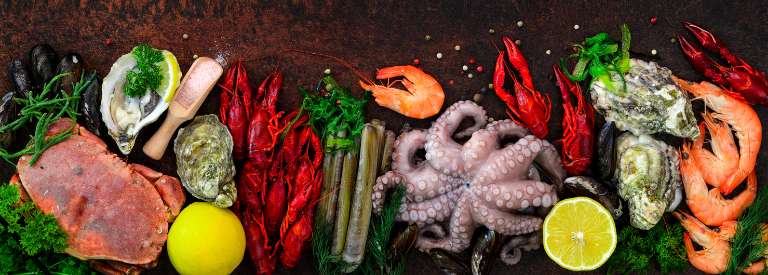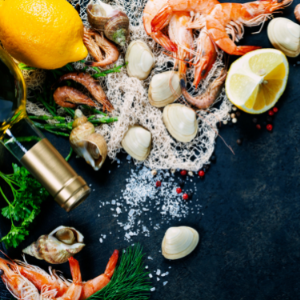Sustainably sourced seafood is fish or other sea life that has been caught or farmed in a way that does not damage the environment. Eco-friendly seafood helps preserve our oceans and waterways. It also prevents the act of overfishing, ensuring that there is seafood available for future generations to enjoy and minimal negative impacts on ocean wildlife habitats.

What Is Overfishing?
Overfishing is the act of taking fish or seafood out of the water at a faster rate than they can reproduce, resulting in underpopulated species. Some causes of overfishing are the increase in human demand, subsidies, irresponsible management of fisheries, and no protective fishing regulations.
Farmed Seafood Vs. Wild-Caught Seafood
Fish and seafood farming is part of "aquaculture," the commercial farming industry of aquatic organisms in enclosures (tanks, pens, or netted areas) for foodservice markets. Wild-caught seafood, another method of harvesting seafood for markets, is when species are naturally caught in their wild habitats. Wild-caught fishing can easily become unsustainable when companies are overfishing. Below are types of overfishing methods that damage our environment.
Unsustainable Wild-Caught Fishing Methods
- Ghost Nets: Fishing nets that are lost or left behind by fishing boats. As they float in the ocean, many sea creatures get trapped inside, leading to the loss of life that was not necessary.
- Bycatch: Marine life that has been unintentionally caught on fishing lines and fishing nets with targeted species. Species that tend to be victims of this are dolphins, sea turtles, and sharks.
Ways To Reduce Unsustainable Wild-Caught Fishing
- Ghost net fishing: Can be reduced by companies not leaving any fishing nets they use in the ocean.
- Overfishing: Can be lessened by understanding which species to avoid based on season and location. Follow organizations that dedicate themselves to balancing fish populations.
- Bycatching: Can be minimized by transitioning to fishing methods with minimal environmental impact like trolling or long lines.
Knowing about these practices can help you be more informed when trying to make a decision on where to source your seafood from. To help the environment, it is also essential for operators to serve sustainably sourced seafood using eco-friendly supplies that help minimize their carbon footprint.
How Do I Know If My Seafood Is Sustainable?
It is vital to understand where your seafood comes from. Unfortunately, not all markets provide information on where their seafood is sourced. If the company you get your seafood from is unaware of its supply chain, then it is best to begin purchasing from another organization. Thankfully, there are many different guides that can help you source the best option for you and your establishment.
- Aquaculture Stewardship Council (ASC): Provides certifications and labeling for responsible farming practices.
- WWF Seafood Guides: Contains multiple guides on where to get sustainably sourced seafood in specific regions.
- Marine Stewardship Council (MSC): A sustainable seafood source that guides how to stop overfishing and catch sustainably.
- Seafood Watch or the Monterey Bay Aquarium's Seafood Guide Rates different types of seafood based on their sustainability.
- Friend of the Sea Certified: Ensures fisheries and aquaculture provide proper treatment to sea life and execute responsible fishing methods.
Most Sustainable Seafood
When deciding to transition to sustainably sourced seafood, it is essential to know which types of seafood have the least impact on the environment. Below is a list of the most sustainable types of seafood you can incorporate into your menu:
- Skipjack tuna: Grows faster than other types of tuna.
- Anchovies: Have a quick growth cycle and repopulate fast.
- Sardines: Repopulate quickly so it is difficult to overfish them.
- Farmed tilapia: Inexpensive to farm due to their plant-based diet.
- Farmed mussels: Do not need resources to produce or land space.
- Farmed scallops: No commercial feeds needed or land to reproduce.
- Pacific cod: Sustainably managed and harvested under U.S regulations.
- Albacore tuna: Caught using minimal environmental impact fishing methods.
- Farmed trout: Managed responsibly by the U.S., with powerful ecological practices.
- Farmed clams: Sustainably harvested due to not needing any land or feed to reproduce.
- Frozen or canned fish: Reduces the carbon footprint that usually goes into importing fish.
- Farmed oysters: Don’t need any commercial feed to be farmed and don't produce waste like fish.
- Farmed Arctic char: Raised in a recirculating aquaculture system (RAS), a non-toxic method of fish farming.
- Wild-caught salmon from Alaska: Usually caught using pole and line or troll methods, which have a minimal environmental impact.
However, not all farmed fish is sustainable and can lead to high amounts of waste, chemical use, unsustainable feed, and separation issues. Farmed seafood, if escaped from their enclosure into the wild, can negatively impact species due to their genetic differences from being separated. By taking these factors into account, fish farms can become more sustainable over time.
Seafood to Avoid
There are numerous seafood options that are largely overfished, and slow to grow and repopulate. If you're looking to incorporate more sustainable seafood into your menu, you should steer clear of the following seafood:
- Eel
- Shrimp
- Salmon
- Atlantic cod
- Bluefin tuna
- Atlantic halibut
- Orange roughly
- Atlantic salmon
- Chilean sea bass
Pros & Cons Of Serving Sustainably Seafood
There are benefits and downsides to serving or buying sustainably sourced seafood. Below are pros and cons to sustainable seafood.
Pros
Adding sustainable seafood options to your menu can help the environment and enhance your establishment's reputation. Now more than ever, people are trying to find ways to improve the environment through their daily choices. With that being said, customers are sure to appreciate seeing sustainable options on your menu, which can increase sales. As a business, you will also be an asset to improving ocean life and its ecosystems by limiting species to become extinct, decreasing pollution, and leading fish populations to thrive in harmony.
Cons
One of the major downsides to having sustainably sourced seafood on your menu is that it can be more expensive. This issue limits the number of people that can access sustainable options. However, there are ways to save money on sustainable seafood, such as buying in bulk, looking for sales, or buying seafood in season.
Make A Difference
While there are some concerns about the sustainability of seafood, choosing wisely and being mindful of our choices, we can all help ensure that seafood remains a good source of protein for us in the years to come. So next time you purchase a supply of seafood, opt for a sustainable alternative from here on.






